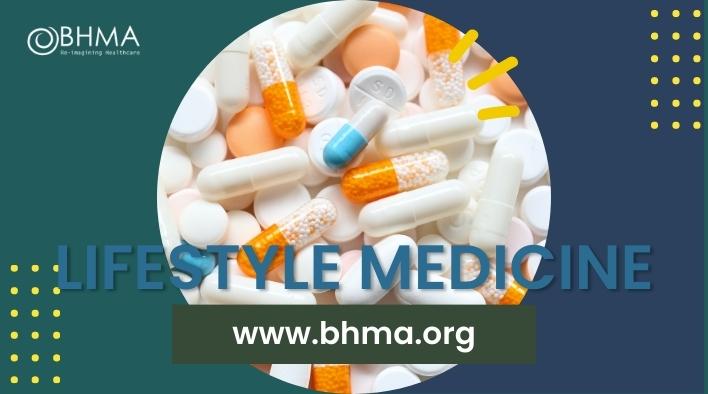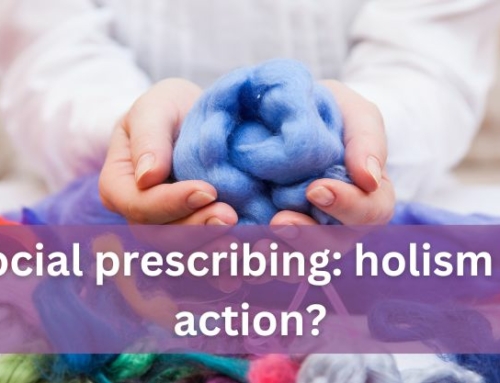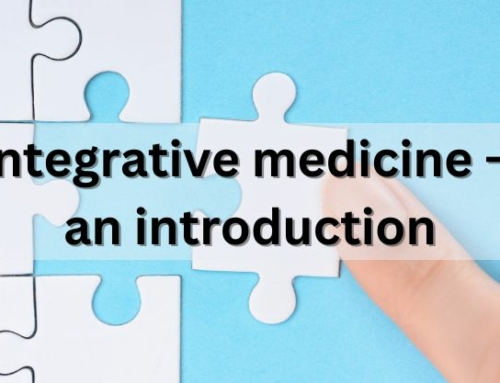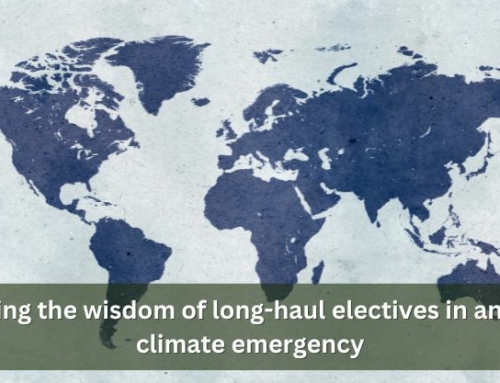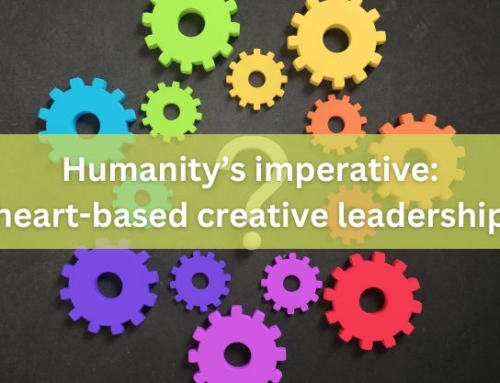Lifestyle medicine
Rob Lawson, General and Lifestyle Medicine Practitioner; Director and owner of CORE HEALTH
Published in JHH13.2 – Nutrition and Lifestyle
My interest in lifestyle determinants of disease began at least 28 years ago. The penicillin of what is now called lifestyle medicine is represented by the management of stress, nutrition and activity. As an NHS GP, only by setting up a registered charity delivering activity classes around my county for people with long-term conditions, was I able to deliver what I considered to be an essential component of holistic and preventive health care.
He who has a why to live, can bear almost any how -Friedrich Nietzche Click To Tweet Most of the doubling of life expectancy over the last century or so has been due to improved nutrition, housing, hygiene, clean water and sanitation. However, we now face a pandemic of chronic (or lifestyle-related) diseases (LRDs). The major causes of chronic diseases are lifestyle related and if these risk factors were eliminated, at least 80% of all heart disease, stroke and type 2 diabetes and over 40% of cancer would be prevented (WHO 2016).
Chronic metabolic inflammation
Pasteur’s germ theory led to cures for infectious diseases. Until now, chronic disease epidemiology has lacked a similar single-cause focus. However, according to Gokhan Hotamisligil at Harvard, a form of low-grade, systemic, and chronic inflammation (metaflammation) underlies many, if not all, chronic diseases. The animal metabolic and immune systems are so essential for survival that these systems evolved a long way back. Consequently these nutrient- and pathogen-sensing systems are highly integrated and their proper functioning is interdependent (Hotamisligil 2006). The failure to co-ordinate this central homeostatic mechanism leads to a cluster of chronic metabolic disorders, particularly obesity, type 2 diabetes and cardiovascular disease.
Anthropogens
Garry Egger, Director of the Centre for Health Promotion and Research in Sydney and Professor of Lifestyle Medicine and Applied Health Promotion at Southern Cross University, has called the main disrupters of this system anthropogens (Egger et al 2015), defining them as man-made environments, their by-products, and/or lifestyles encouraged by these, some of which are detrimental to human health. A broad classification of anthropogens associated with chronic disease can help us focus the practice of lifestyle medicine and could in time shift medical thinking (and our whole culture) towards what needs to be done to bring about real improvement in healthy life expectancy.
The anthropogens proposed by Garry Egger et al can be grouped under the acronym NASTIE ODORS. The grouping is reproduced with his permission.
Nutrition (over and under)
Excess energy intake, even of healthy foods can be pro-inflammatory and this tendency is made worse in foods that have been refined or processed. The hazards of obesity and the benefits of fat loss are well established.
Inadequate and/or over-nutrition account for a significant proportion of risk for chronic conditions like vascular disease, type 2 diabetes and certain cancers. Studies have reported increased risk from excessive amounts of total energy, sugars, salt, alcohol, and (saturated and trans) fats, as well as inadequate levels of fibre, fruit, vegetables and certain nutrients. Levels of processing have been proposed as a general indicator of risk, and there appears to be a clear ‘metaflammatory’ spectrum from natural, whole foods to ultra-processed foods and fluids.
Activity/Inactivity
This has been linked to over 35 different diseases, and we know too that aerobic activity, increased flexibility and balance all enhance quality of life.
The lack of regular, extended, physical activity is a significant driver of chronic disease in modern societies, with links to numerous common chronic conditions. Many social and cultural factors encourage a lifestyle of inadequate exercise and work-related movement. Excessive sitting may have an independent negative effect.
Weight gain is often a consequence of inactivity and over-nutrition, but inflammatory processes can occur without obesity suggesting these are independent determinants of disease.
Stress, anxiety and depression
Sustained activation of the hypothalamic–pituitary–adrenal (HPA) axis is unhealthy.
While no doubt existing in all human societies, the seasonal affective disorder (SAD) phenomena appear to have risen to epidemic proportions in modern western cultures. Chronic psychological stress has been shown to trigger pathological pathways such as meta-inflammation. The link with heart disease and other chronic ailments is increasingly understood and interventions aimed at reducing or managing stress as a precursor are high on the list of lifestyle and behavioural prescriptions at the primary care level.
Technopathology
This varies from the effects of war, motor accidents, loud music, radio frequency radiation to Facebook-linked depression and RSI.
Changes in society invariably lead to changes in the types of diseases in those societies. Although not (yet) a widespread, or accepted term, technology-induced pathology is a way of categorising the ill-health effects of certain aspects of modern technology. It explains trauma from hi-tech warfare weaponry, motor vehicle or machinery use at one extreme, to auditory problems and changes in brain chemistry from extended computer and small screen use at the other.
The increasing use of technology can also alter other behaviours such as nutrition (snacking) and reduced physical activity (TV, computer usage). However, technology also has the potential to be part of the solution in chronic disease management.
Inadequate sleep
At some point 80% of us have suffered this. The impact of sleep disturbances – hypopnoea as well as insomnia – is under-rated by doctors.
The impact of sleep disturbances – hypopnoea as well as insomnia – is under-rated by doctors
Our internal (circadian) clock – regulated in the suprachiasmatic nucleus, a tiny region of the brain in the hypothalamus – controls the timing of sleep and wakefulness as well as many physiological functions. An interruption of this chrono-biological systems is linked to metabolic disorders and chronic diseases. Poor sleep may be one of the most under-recognised lifestyle determinants of chronic disease epidemiology. The practice of going to sleep and waking up at ‘unnatural’ times has been described as the most prevalent high-risk behaviour in modern society and has been termed ‘social jetlag’. This can result not only from sleep disorders, but also more from late night leisure activities, entertainment, drug use, and many aspects of modern life, perhaps especially late night screen use. It links closely with other determinants such as poor diet, fatigue and inactivity and acts as a stressor leading to anxiety and depression.
Environment
This includes physical, economic policy and socio-cultural environments. In addition the impact on our in-vironment of pollutants and endocrine-disrupting chemicals (EDCs), though hard to quantify scientifically, is almost certainly significant.
The impact of EDCs is widely unacknowledged despite growing evidence that they contribute to reproductive disorders, immune and auto-immune disease, cardio[1]pulmonary disease and disorders of the brain and nervous system. Children are the most vulnerable to these impacts (Bergman et al 2012).
The social, economic and political environments play an obvious role in maintaining these pathologies. The intra-uterine environment is increasingly recognised as having a long-term effect on health. Adverse childhood experiences make a lifelong impression on resilience and susceptibility to mental and physical health.
“Keep me away from the wisdom that does not cry and the philosophy that does not laugh and the greatness which does not bow before children.”
(the Prophet, Kahil Gibram)
In-vironment
This is a novel concept aimed at recognising that various newly discovered internal ecologies may be playing an important part in chronic disease. .The microbiota is the ecological community of commensal, symbiotic and pathogenic micro-organisms that share our body space. The gut microbiota (formerly called gut flora) is the microbe population living in our intestine. Our gut microbiota contains tens of trillions of micro-organisms, including at least 1000 different species of known bacteria with more than 3 million genes (150 times more than human genes).They are essential for proper digestion including the breakdown of complex carbohydrates, dietary fibres, production of short chain fatty acids and synthesis of some vitamins. Micro-organisms in the gut also secrete a number of chemicals, among which are the same substances used by neurons to communicate and regulate mood, like dopamine, serotonin and gamma-aminobutyric acid (GABA). Because the intestinal microbiota influences many of our metabolic functions it has implications for the susceptibility to chronic diseases and obesity.
Meaninglessness
Perhaps not unexpectedly, meaning or purpose in life has been linked with better long-term health and healthcare behaviours. People with more purpose in life, for example, have been found to have better patterns of healthcare use, which might explain why they are known to have better health.
Perhaps not unexpectedly, meaning or purpose in life has been linked with better long-term health and healthcare behaviours. People with more purpose in life, for example, have been found to have better patterns of healthcare use, which might explain why they are known to have better health.
The reasons for the effect of meaninglessness on health outcomes are multiple
Meaninglessness, learned helplessness or hopelessness are all associated with persistent elevated cortisol levels, raised inflammatory markers and cardiovascular disease. The reasons for the effect of meaninglessness on health outcomes are multiple but probably contribute to the poor health associated with social deprivation/poverty. Whatever the link, we do know that 32% of the attributable risk in heart attacks is due to psychosocial issues. On the other hand, those at risk who escape meaninglessness have been shown to have a social cohesion and resilience: they can make sense of what is happening to them and can respond.
Alienation
Alienation, or estrangement, can result from many factors – discrimination, social isolation, rejection, or adverse childhood experiences (ACEs). It can be the result of separation from friends, family, peers, society or man[1]made and natural disasters. It may reflect social isolation early in life and and social inequality. Emotional distress and loss of control may be mediating factors in the recognised link between alienation and adverse cardiac events.
‘Let me at the onset define what I mean by alienation. It is the cry of men who feel themselves the victims of blind economic forces beyond their control. It’s the frustration of ordinary people excluded from the processes of decision-making. The feeling of despair and hopelessness that pervades people who feel with justification that they have no real say in shaping or determining their own destinies.’
Jimmy Reid, 1972
Loss of culture/identity
Loss of culture and/or identity are significant factors in displaced Indigenous and First Nation populations, confused identity around sexual orientation or in the wake of family disruption. It can also occur as a result of warfare or natural disasters where cultures are either wiped out or relocated from areas they have inhabited for generations. Despite the paucity of data on this in the health literature, there are indications of connections with chronic disease outcomes in several population groups.
Occupation
Taken broadly to include ways of occupying one’s time – habits, hobbies and interests – ‘occupation’ on the one hand can influence health directly through injury (such as a sport) or repeated exposure to toxins. Occupational hazard may also act through less direct processes: shift[1]work effects on physiological function, or ‘burnout’ and economic insecurity relating to employment status. These factors interact with other anthropogens such as stress, meaninglessness and relationships, and their link with metaflammation. Changes in the nature and security of work in the modern world mean that both the physical and psychological components of occupations and interests need to be considered part of a lifestyle/ environmental perspective on health.
Drugs, smoking and (excessive) alcohol
Drugs, both legal and illicit, prescribed and non[1]prescribed are responsible for significant and increasing morbidity and mortality. Iatrogenic disease is a major killer – unintended though it may be. Tobacco smoke is a proven toxicant with over 300 chemicals and links with cancers, heart disease and respiratory problems. Tobacco control in most modern western countries however has been one of the big success stories of health promotion and lifestyle medicine. Alcohol is rather more complicated: it has possible benefits at low doses, but excessive and binge drinking cause chronic problems such as liver disease, and negative behaviours that lead to injuries and domestic violence.
Over- and under- exposure
The biochemical reactions that support life are complex and often non-linear. So too are the interactions of chronic disease risk factors such as blood pressure, lipid levels and body composition. This can confuse and hinder our understanding and lead to misconceptions about risk and disease management. A certain amount of physical activity or sleep, for example, is considered healthy (and reduces the risk for chronic diseases), whereas overdosing or underdosing clearly increase chronic disease risk.
Exposure to ultra-violet radiation (UVR) from sunlight follows a similar ‘U’ or ‘tick-shaped’ (non-linear) relationship with health. UVR is a carcinogen and a major determinant for several forms of skin disorders. Overexposure to heat and dryness (low humidity) is also thought to have adverse effects on the skin. Under[1]exposure to sunlight on the other hand can lead to vitamin D deficiency, and in some instances Seasonal Affective Disorders (SAD).
Relationships
The quality of personal and social relationships is clearly linked to chronic disease outcomes including heart disease, stroke, some cancers, and all-cause mortality. Adverse childhood experiences (ACEs) and loneliness are in this category as well as in environmental exposures and alienation. As yet, the causal pathways are unclear, but meta-inflammatory processes have been associated with poor social support and social support is thought to alleviate inflammation associated with childhood adversities (Runsten et al 2014). Improving awareness of the importance of social support and assisting access to such support should be integral to chronic disease management.
Social inequality
Gaps between the rich and poor in a nation or community add to the effects of poor inter-personal relationships on chronic disease as illustrated by epidemiological studies using relative income differentials within and between countries. The mechanisms remain unclear but metaflammation appears again to play a mediating role in chronic diseases associated with such inequality.
Now if, by definition, these anthropogens are man-made then surely they can be man-unmade- but not in a ten minute GP appointment in the UK. The key to making any impact on the Tsunami wave of long-term conditions or LRDs and also on the rise in acute infections heading our way, is to tackle these determinants at source. Deal with the causes and the causes of the causes.
The art of lifestyle medicine
Since these anthropogens are man-made, they can surely be man-unmade But not in the ten minute appointment that is now all most GPs have in the UK. The key to making any impact on the tsunami of long-term lifestyle[1]related diseases, and the rise in acute infections which is also heading our way, will be to tackle these determinants at source. We must deal with the causes and the causes of the causes.
Diagnosis in lifestyle medicine is focused on the underlying mechanisms and determinants of disease rather than the disease itself. Most chronic diseases share common mechanisms, (such as metaflammation (Gregor and Hotamisligil 2011)) and signs in clinical practice (such as elevated inflammatory markers). Addressing these factors can improve risks for several diseases. For example, obesity is a function of energy imbalance, but energy intake (food and drink) and energy expenditure (meta – bolism, physical activity) can be influenced by a range of other, less obvious, factors, which need to be considered in any systems-model approach. Stress, for example, can influence (positively or negatively) energy intake and metabolism, as well as activity levels. Inadequate sleep can lead to low activity levels during the day, which then impact on diet and relationships and which can ultimately effect body weight outcomes.
The key to making any impact on the tsunami of long-term lifestyle related diseases… will be to tackle the determinants at source. We must deal with the causes and the causes of the causes.
Prescription in lifestyle medicine may involve pharmaceutical as well as non-pharmaceutical interventions, although medication is most often an adjunct to a therapeutic lifestyle intervention (TLI, behaviour change), rather than the primary treatment. Medication is aimed primarily at disease or risk[1]modification, whereas long-term management relies on upstream lifestyle change .
It is important to share a full understanding with your patients of their health risk and the potential benefit (in terms of the numbers needed to harm (NNH) and numbers needed to treat (NNT). Charts, diagrams or online quizzes (eg www.mayoclinic.org/diseases[1]conditions/heart-disease/in-depth/heart-disease-risk/ itt-20084942 can be useful motivators.
De-prescription
The over-use of medications and multiple prescribing have become so common in affluent societies, particularly in the elderly, that de-prescribing techniques are needed. We may soon have to help patients reduce their meds either because they are not benefitting from them or are actively causing harm. Such skills are likely to become a standard procedure in managing chronic diseases in the future.
The process of de-prescribing is laced with many challenges for GPs. The uncertainty of research evidence in older people and social factors such as specialists’ and nurses’ influences were among the major challenges identified. De-prescribing enablers encompassed support for GPs’ awareness and knowledge, improvement of communication between multiple prescribers, adequate reimbursement and pharmacists being involved in the multidisciplinary team (Ailabouni et al 2016).
Motivational skills
While all the usual counselling skills such as motivational interviewing, health coaching, interpersonal relationship training, cognitive behaviour therapy, self-management training are necessary in lifestyle medicine, they may not be sufficient for dealing with the behaviours and the environments which are driving chronic diseases. Management may therefore require different procedures, such as group education.
Changing behaviour is challenging for anyone (for doctors no less than patients). As doctors we need to be convinced of the evidence for taking on the challenge; that the science is robust, which it is. The change journey has to move someone from the extrinsic motivation of superficial, short-lasting pleasures (hedonia) to the kind of intrinsic motivation where there develops a sense of satisfaction, meaning and purpose (eudaimonia) in regaining overall wellbeing and achieving longer-term goals. As doctors we are important players in this – if we recognise the science as being robust, which it is.
Shared medical appointments
The tools for delivering lifestyle medicine include brief interventions in the 1:1 consultation that GPs are used to. But there is another way: an approach that improves outcomes for individuals, especially but not exclusively for those of low health literacy, in a meaningful and engaging way. What’s more it’s a way of doctoring that clinicians actually find enjoyable. Once undertaken, colleagues have declared themselves hooked! Shared medical appointments (SMA) (Lawson 2016) have been known by other names – group consultations are mentioned in NHS England’s Forward View document. But when selling it to patients, it would be understandable if the name ‘shared medical appointment’ had more of an appeal.
As the rise of chronic 21st century lifestyle-related disease (LRD) continues unabated, alternative ways of managing them will have to be subject to rigorous testing in structured trials. Meanwhile lifestyle medicine is worth debating, and there is nothing to stop willing, curious GPs adopting this wider view of chronic diseases and ways of preventing and treating them by addressing their cultural psychological and behavioural roots. As healthcare providers we can all try to coach, coax and nudge our patients (and critically, ourselves) into a healthier environments and ways of life. Unless we do so, the future landscape of primary care will be littered with over[1]diagnosis and over-prescription.
Shared medical appointments are a way of doctoring that clinicians actually find enjoyable. Once undertaken, colleagues have declared themselves hooked!
Professional associations for Lifestyle Medicine are already active in the US, Europe, South America, Australasia and are being developed in other countries. Post-graduate specialties are currently offered in a number of universities. Yet apart from recognising lifestyle and behavioural factors in disease, the field has yet to develop its own pedagogy. If it is to have a place in the NHS, its contributions to existing care needs to be promoted. To this end a British Society of Lifestyle Medicine is forming and it welcomes would-be members who want to join with others to advance the principles of lifestyle medicine.
References
- Ailabouni NJ, Nishtala PS, Mangin D, Tordoff JM (2016) Challenges and enablers of deprescribing: a general practitioner perspective. PLoS One 11(4) e0151066. doi: 10.1371/journal.pone.0151066.
- Bergman A, Heindel JJ, Jobling S, Kidd K, Thomas Zoeller R (eds) (2013) State of the science of endocrine disrupting chemicals – 2012. Geneva: UNEP/WHO. Available at: http://unep.org/pdf/9789241505031_ eng.pdf (accessed 30 August 2016).
- Egger G, Colquhoun D, Dixon J (2015) ‘Anthropogens’ in lifestyle medicine. American Journal of Lifestyle Medicine 9 (3) pp 232–240. First published December 5, 2013.
- Gregor MF, Hotamisligil GS (2011) Inflammatory mechanisms in obesity. Annu Rev Immunol 29, pp415–45. doi: 10.1146/annurev[1]immunol-031210-101322.
- Hotamisligil GS (2006) Inflammation and metabolic disorders. Nature 444 (7121) pp 860–7.
- Lawson R (2016) Shared medical appointments in the UK. Available at: www.rcgp.org.uk/clinical-and-research/bright-ideas/shared-medical[1]appointments-in-the-uk-dr-rob-lawson.aspx (accessed 30 August 2016).
- Runsten S, Korkeila K, Koskenvuo M, Rautava P, Vainio O, Korkeila J (2014) Can social support alleviate inflammation associated with childhood adversities? Nord J Psychiatry 68(2) pp 137–44. doi: 10.3109/08039488.2013.786133.
- WHO (2016) Chronic diseases and health promotion. Available at: www.who.int/chp/chronic_disease_report/part1/en/index11.html (accessed 30 August 2016).

